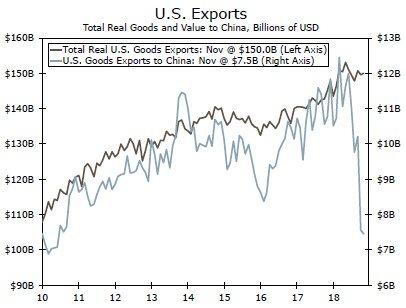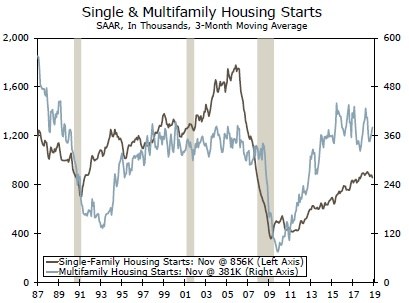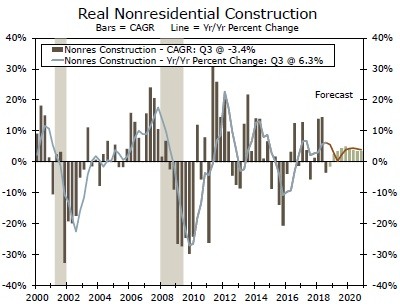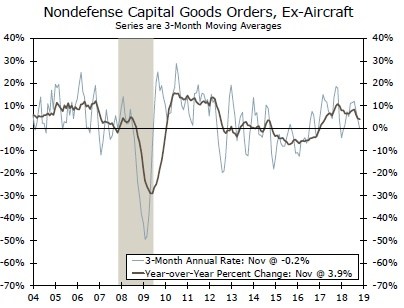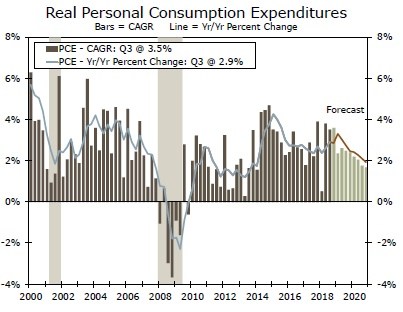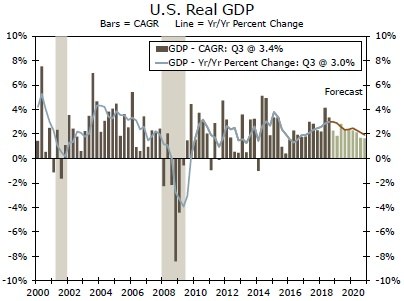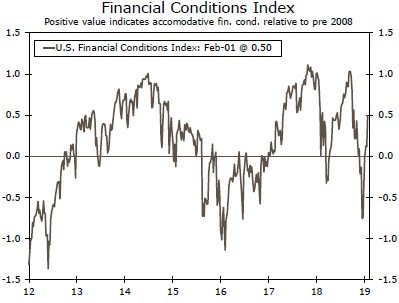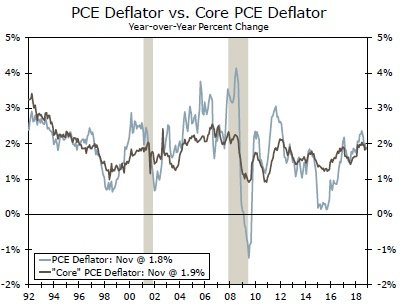Executive Summary
Federal Reserve Chairman Powell noted that there were "crosscurrents" that were impacting the U.S. economy when he discussed the outlook for monetary policy at the conclusion of the January 30 meeting of the Federal Open Market Committee (FOMC). Exports and the housing market are exerting some headwinds on growth at present and business fixed investment is moving more or less sideways, but consumer and government spending are both growing at strong rates. The FOMC has said that it can be "patient," and most market participants currently believe that the Fed is done hiking rates.
We agree that the FOMC likely will remain on hold in coming months as it assesses the outlook for the U.S. economy, but we think it would be premature to claim that this Fed tightening cycle is now over. If, as we forecast, the economy continues to grow at an above-trend rate in coming months, then we look for the FOMC to tap on the brakes again with a 25 bps rate hike this summer or in the early autumn.
Is the Fed Really Done Hiking Rates?
At his press conference following the January 30 meeting of the FOMC, Chairman Jerome Powell noted that there were "crosscurrents" that were impacting the U.S. economy at present. Given the noticeably dovish tone to the FOMC statement, which was reinforced by Powell's press conference comments, financial markets are currently priced for no further rate hikes in this cycle. Have the "crosscurrents" that Powell referenced caused the economy to slow enough to remove the need for further rate hikes or will the FOMC eventually resume tightening? Could the next move in the Fed's policy rates be a cut? In an effort to answer these questions, we will discuss different spending categories in this report to determine how the overall U.S. economy is faring at present and the implications of that analysis for the outlook for Fed policy.
Swimming Against the Current
There are some spending categories that are swimming against the current at present. Start with the foreign sector. The value of American exports to China has nosedived in recent months due to the one-two punch of slower economic growth in China combined with Chinese tariffs on American goods (Figure 1). China accounts for only 8% of total U.S. exports, so the collapse in U.S. exports to China has not been replicated in the total. Nevertheless, total real exports of goods have been more or less flat in recent months (Figure 1). In other words, the contribution to U.S. economic growth from real exports has weakened recently.
The housing market also appears to be swimming against the current at present. Multifamily housing starts have been choppy but they have been more or less flat on balance for some time, while single-family starts have rolled over recently (Figure 2). The rise in mortgage rates and the marked increase in home prices in many parts of the country over the past few years have eroded affordability. Spending on real residential construction fell 2.1% between Q4-2017 and Q3-2018, and we project that residential construction contracted again in the fourth quarter.
That said, we look for some eventual turnaround in these spending categories. Although foreign economic growth has decelerated, we expect that most foreign economies will avoid an outright recession. We also anticipate that the United States and China will reach an agreement within the next month or so on a trade deal or, at a minimum, trade tensions between the world's two largest economies will not escalate further. Consequently, real exports of goods and services in the United States should trend higher in coming quarters, albeit at a modest rate of growth. Likewise, wwhich account for roughly one-third of total residential investment, continue to grow
at a solid rate.1e look for some uptick in residential construction in coming quarters. The rate on the 30-year fixed-rate mortgage has declined half a percentage point since mid-November, which has contributed to a rebound in mortgage applications so far this year. Furthermore, improvements to the existing housing stock, which account for roughly one-third of total residential investment, continue to grow at a solid rate.1
Swimming Across the Stream
The nonresidential construction sector has had a mixed performance in recent quarters. Spending in this sector was very strong at the beginning of 2018 (Figure 3). High oil prices in the first half of the year led to rapid growth in investment in the energy sector. (Spending on structures in the energy sector shows up in the nonresidential construction component of the GDP accounts.) But, nonresidential construction contracted more than 3% at an annualized rate in Q3-2018, and we estimate that it slid a bit further in the fourth quarter. That said, we look for further gains in this sector, albeit at a modest pace, in coming quarters. Construction in the industrial sector, which includes warehouses, should remain strong, and we also look for modest rates of growth in offices and hotels.
Growth in other areas of business investment spending has also softened recently. Real spending on equipment was robust in the second half of 2017 and early in 2018. However, growth in this category of spending downshifted to only 3.4% at an annualized rate in Q3-2018. New orders for non-defense capital goods (excluding aircraft), which is a leading indicator of real equipment spending, have decelerated significantly in recent months (Figure 4). Perhaps uncertainty related to trade policy is contributing to the recent slowdown in equipment spending. But whatever the catalyst(s), the near-term outlook for business spending on equipment does not look very strong. That said, sustained declines in business spending on equipment do not appear to be likely. As noted above, we look for some de-escalation of trade tensions with China in the next few months. Moreover, spending on intellectual property products (IPP), which accounts for one-third of total business fixed investment spending, has been growing strongly in recent quarters.2
Swimming With the Current
The categories of spending discussed above are either exerting some headwinds on the rate of real GDP growth in the United States or they are not adding much momentum at present. Fortunately, there are two spending categories, one relatively small but one large, that are growing at solid rates. Let's start with government spending, the smaller of the two categories, which was up 2.3% on a year-ago basis in Q3-2018 (Figure 5). Congress increased federal government spending significantly as part of the budget agreement in February 2018. Although the positive impulse to real GDP growth from federal spending appears to be close to peaking, we estimate that government spending will continue to make positive contributions to growth, albeit at diminishing rates, through the end of 2020.
Personal consumption expenditures (PCE), which comprise two-thirds of GDP, have grown at a robust rate in recent quarters (Figure 6). Employment growth has been strong and wages have accelerated. Both of these developments have generated meaningful growth in real income, which has underpinned the heady growth rates of real PCE that have been registered recently.3 Furthermore, the personal tax cuts that took effect in early 2018 provided a boost to real disposable income for many households. Looking forward, we forecast that growth in real PCE will downshift a bit as the effects of the tax cuts start to wear off. But we expect that growth in real PCE will generally remain solid in coming quarters as strong growth in employment continues to support growth in real income.
So where does all this leave us? We estimate that U.S. real GDP rose 3.0% on a year-ago basis in Q4-2018. Although we look for some deceleration in 2019—we forecast that the year-over-year rate of real GDP growth will slow to 2.4% by Q4—we expect that the expansion will remain intact (Figure 7).4 Not only is our GDP forecast for 2019 more or less in line with the FOMC's forecast, but it is above the FOMC's estimate of the long-run potential growth rate.5
How Will the FOMC Navigate the "Crosscurrents"?
The FOMC hiked rates on December 19, and Chairman Powell suggested in his post-meeting press conference that more tightening was likely. With many economies showing signs of deceleration and with plenty of other economic policy uncertainty at the time, financial market participants were not pleased with the hawkish tone of the Fed. As shown in Figure 8, the Bloomberg financial conditions index tightened significantly at the end of last year (a movement lower in the index indicates that financial conditions have tightened). Not only did the stock market swoon, but corporate bond spreads widened markedly. If sustained, a tightening in overall financial conditions could lead to slower economic growth.
The FOMC decided to keep its target range for the fed funds rate unchanged at its January 30 policy meeting, which was universally expected. Moreover, the committee indicated that it will be "patient" as it contemplates its next move. Because rates of PCE inflation are currently near the Fed's target of 2% and showing few signs of moving higher at this time (Figure 9), the FOMC can afford to take a wait-and-see approach.
But we think it would be premature to claim that this Fed tightening cycle is now over, as is currently indicated by financial prices. For starters, financial conditions have relaxed since the turn of the year, which improves the growth outlook, everything else equal. Moreover, as outlined above, the expansion seems likely to continue, which the FOMC acknowledged on January 30.6 We agree that the FOMC likely will remain on hold in coming months as it assesses the economy. But if the economy continues to grow at an above-trend pace, which would cause the unemployment rate to recede further, then we think the FOMC will decide to bump rates up again 25 bps in late summer/early autumn. We then look for the committee to remain on hold through most of 2020 as the economy slowly loses momentum, and we forecast that conditions will be in place to induce the FOMC to start cutting rates at the end of 2020.
Conclusion
Many financial market participants seem to think that the FOMC is done hiking rates in this cycle. Although we agree that the committee likely will be on hold for the foreseeable future, we think it is premature to declare an end to the tightening cycle. Financial conditions, which tightened considerably at the end of last year, have eased in recent weeks. There clearly are some "crosscurrents" which are impacting the U.S. economy at present, but on balance the economy appears to be swimming with the current. If, as we forecast, the economy continues to grow at an above-trend rate in coming months, then we look for the FOMC to tap on the brakes again with a 25 bps rate hike this summer or in the early autumn.
Recently, the stock market has experienced high levels of volatility. If you are thinking about participating in fast moving markets, please take the time to read the information below. Wells Fargo Investments, LLC will not be restricting trading on fast moving securities, but you should understand that there can be significant additional risks to trading in a fast market. We've tried to outline the issues so you can better understand the potential risks. If you're unsure about the risks of a fast market and how they may affect a particular trade you've considering, you may want to place your trade through a phone agent at 1-800-TRADERS. The agent can explain the difference between market and limit orders and answer any questions you may have about trading in volatile markets. Higher Margin Maintenance Requirements on Volatile Issues The wide swings in intra-day trading have also necessitated higher margin maintenance requirements for certain stocks, specifically Internet, e-commerce and high-tech issues. Due to their high volatility, some of these stocks will have an initial and a maintenance requirement of up to 70%. Stocks are added to this list daily based on market conditions. Please call 1-800-TRADERS to check whether a particular stock has a higher margin maintenance requirement. Please note: this higher margin requirement applies to both new purchases and current holdings. A change in the margin requirement for a current holding may result in a margin maintenance call on your account. Fast Markets A fast market is characterized by heavy trading and highly volatile prices. These markets are often the result of an imbalance of trade orders, for example: all "buys" and no "sells." Many kinds of events can trigger a fast market, for example a highly anticipated Initial Public Offering (IPO), an important company news announcement or an analyst recommendation. Remember, fast market conditions can affect your trades regardless of whether they are placed with an agent, over the internet or on a touch tone telephone system. In Fast Markets service response and account access times may vary due to market conditions, systems performance, and other factors. Potential Risks in a Fast Market "Real-time" Price Quotes May Not be Accurate Prices and trades move so quickly in a fast market that there can be significant price differences between the quotes you receive one moment and the next. Even "real-time quotes" can be far behind what is currently happening in the market. The size of a quote, meaning the number of shares available at a particular price, may change just as quickly. A real-time quote for a fast moving stock may be more indicative of what has already occurred in the market rather than the price you will receive. Your Execution Price and Orders Ahead In a fast market, orders are submitted to market makers and specialists at such a rapid pace, that a backlog builds up which can create significant delays. Market makers may execute orders manually or reduce size guarantees during periods of volatility. When you place a market order, your order is executed on a first-come first-serve basis. This means if there are orders ahead of yours, those orders will be executed first. The execution of orders ahead of yours can significantly affect your execution price. Your submitted market order cannot be changed or cancelled once the stock begins trading. Initial Public Offerings may be Volatile IPOs for some internet, e-commerce and high tech issues may be particularly volatile as they begin to trade in the secondary market. Customers should be aware that market orders for these new public companies are executed at the current market price, not the initial offering price. Market orders are executed fully and promptly, without regard to price and in a fast market this may result in an execution significantly different from the current price quoted for that security. Using a limit order can limit your risk of receiving an unexpected execution price. Large Orders in Fast Markets Large orders are often filled in smaller blocks. An order for 10,000 shares will sometimes be executed in two blocks of 5,000 shares each. In a fast market, when you place an order for 10,000 shares and the real-time market quote indicates there are 15,000 shares at 5, you would expect your order to execute at 5. In a fast market, with a backlog of orders, a real-time quote may not reflect the state of the market at the time your order is received by the market maker or specialist. Once the order is received, it is executed at the best prices available, depending on how many shares are offered at each price. Volatile markets may cause the market maker to reduce the size of guarantees. This could result in your large order being filled in unexpected smaller blocks and at significantly different prices. For example: an order for 10,000 shares could be filled as 2,500 shares at 5 and 7,500 shares at 10, even though you received a real-time quote indicating that 15,000 shares were available at 5. In this example, the market moved significantly from the time the "real-time" market quote was received and when the order was submitted. Online Trading and Duplicate Orders Because fast markets can cause significant delays in the execution of a trade, you may be tempted to cancel and resubmit your order. Please consider these delays before canceling or changing your market order, and then resubmitting it. There is a chance that your order may have already been executed, but due to delays at the exchange, not yet reported. When you cancel or change and then resubmit a market order in a fast market, you run the risk of having duplicate orders executed. Limit Orders Can Limit Risk A limit order establishes a "buy price" at the maximum you're willing to pay, or a "sell price" at the lowest you are willing to receive. Placing limit orders instead of market orders can reduce your risk of receiving an unexpected execution price. A limit order does not guarantee your order will be executed -" however, it does guarantee you will not pay a higher price than you expected. Telephone and Online Access During Volatile Markets During times of high market volatility, customers may experience delays with the Wells Fargo Online Brokerage web site or longer wait times when calling 1-800-TRADERS. It is possible that losses may be suffered due to difficulty in accessing accounts due to high internet traffic or extended wait times to speak to a telephone agent. Freeriding is Prohibited Freeriding is when you buy a security low and sell it high, during the same trading day, but use the proceeds of its sale to pay for the original purchase of the security. There is no prohibition against day trading, however you must avoid freeriding. To avoid freeriding, the funds for the original purchase of the security must come from a source other than the sale of the security. Freeriding violates Regulation T of the Federal Reserve Board concerning the extension of credit by the broker-dealer (Wells Fargo Investments, LLC) to its customers. The penalty requires that the customer's account be frozen for 90 days. Stop and Stop Limit Orders A stop is an order that becomes a market order once the security has traded through the stop price chosen. You are guaranteed to get an execution. For example, you place an order to buy at a stop of $50 which is above the current price of $45. If the price of the stock moves to or above the $50 stop price, the order becomes a market order and will execute at the current market price. Your trade will be executed above, below or at the $50 stop price. In a fast market, the execution price could be drastically different than the stop price. A "sell stop" is very similar. You own a stock with a current market price of $70 a share. You place a sell stop at $67. If the stock drops to $67 or less, the trade becomes a market order and your trade will be executed above, below or at the $67 stop price. In a fast market, the execution price could be drastically different than the stop price. A stop limit has two major differences from a stop order. With a stop limit, you are not guaranteed to get an execution. If you do get an execution on your trade, you are guaranteed to get your limit price or better. For example, you place an order to sell stock you own at a stop limit of $67. If the stock drops to $67 or less, the trade becomes a limit order and your trade will only be executed at $67 or better. Glossary All or None (AON) A stipulation of a buy or sell order which instructs the broker to either fill the whole order or don't fill it at all; but in the latter case, don't cancel it, as the broker would if the order were filled or killed. Day Order A buy or sell order that automatically expires if it is not executed during that trading session. Fill or Kill An order placed that must immediately be filled in its entirety or, if this is not possible, totally canceled. Good Til Canceled (GTC) An order to buy or sell which remains in effect until it is either executed or canceled (WellsTrade® accounts have set a limit of 60 days, after which we will automatically cancel the order). Immediate or Cancel An order condition that requires all or part of an order to be executed immediately. The part of the order that cannot be executed immediately is canceled. Limit Order An order to buy or sell a stated quantity of a security at a specified price or at a better price (higher for sales or lower for purchases). Maintenance Call A call from a broker demanding the deposit of cash or marginable securities to satisfy Regulation T requirements and/or the House Maintenance Requirement. This may happen when the customer's margin account balance falls below the minimum requirements due to market fluctuations or other activity. Margin Requirement Minimum amount that a client must deposit in the form of cash or eligible securities in a margin account as spelled out in Regulation T of the Federal Reserve Board. Reg. T requires a minimum of $2,000 or 50% of the purchase price of eligible securities bought on margin or 50% of the proceeds of short sales. Market Makers NASD member firms that buy and sell NASDAQ securities, at prices they display in NASDAQ, for their own account. There are currently over 500 firms that act as NASDAQ Market Makers. One of the major differences between the NASDAQ Stock Market and other major markets in the U.S. is NASDAQ's structure of competing Market Makers. Each Market Maker competes for customer order flow by displaying buy and sell quotations for a guaranteed number of shares. Once an order is received, the Market Maker will immediately purchase for or sell from its own inventory, or seek the other side of the trade until it is executed, often in a matter of seconds. Market Order An order to buy or sell a stated amount of a security at the best price available at the time the order is received in the trading marketplace. Specialists Specialist firms are those securities firms which hold seats on national securities exchanges and are charged with maintaining orderly markets in the securities in which they have exclusive franchises. They buy securities from investors who want to sell and sell when investors want to buy. Stop An order that becomes a market order once the security has traded through the designated stop price. Buy stops are entered above the current ask price. If the price moves to or above the stop price, the order becomes a market order and will be executed at the current market price. This price may be higher or lower than the stop price. Sell stops are entered below the current market price. If the price moves to or below the stop price, the order becomes a market order and will be executed at the current market price. Stop Limit An order that becomes a limit order once the security trades at the designated stop price. A stop limit order instructs a broker to buy or sell at a specific price or better, but only after a given stop price has been reached or passed. It is a combination of a stop order and a limit order. These articles are for information and education purposes only. You will need to evaluate the merits and risks associated with relying on any information provided. Although this article may provide information relating to approaches to investing or types of securities and investments you might buy or sell, Wells Fargo and its affiliates are not providing investment recommendations, advice, or endorsements. Data have been obtained from what are considered to be reliable sources; however, their accuracy, completeness, or reliability cannot be guaranteed. Wells Fargo makes no warranties and bears no liability for your use of this information. The information made available to you is not intended, and should not be construed as legal, tax, or investment advice, or a legal opinion.
Recommended Content
Editors’ Picks

EUR/USD consolidates weekly gains above 1.1150
EUR/USD moves up and down in a narrow channel slightly above 1.1150 on Friday. In the absence of high-tier macroeconomic data releases, comments from central bank officials and the risk mood could drive the pair's action heading into the weekend.

GBP/USD stabilizes near 1.3300, looks to post strong weekly gains
GBP/USD trades modestly higher on the day near 1.3300, supported by the upbeat UK Retail Sales data for August. The pair remains on track to end the week, which featured Fed and BoE policy decisions, with strong gains.

Gold extends rally to new record-high above $2,610
Gold (XAU/USD) preserves its bullish momentum and trades at a new all-time high above $2,610 on Friday. Heightened expectations that global central banks will follow the Fed in easing policy and slashing rates lift XAU/USD.

Pepe price forecast: Eyes for 30% rally
Pepe’s price broke and closed above the descending trendline on Thursday, eyeing for a rally. On-chain data hints at a bullish move as PEPE’s dormant wallets are active, and the long-to-short ratio is above one.

Bank of Japan set to keep rates on hold after July’s hike shocked markets
The Bank of Japan is expected to keep its short-term interest rate target between 0.15% and 0.25% on Friday, following the conclusion of its two-day monetary policy review. The decision is set to be announced during the early Asian session.

Moneta Markets review 2024: All you need to know
VERIFIED In this review, the FXStreet team provides an independent and thorough analysis based on direct testing and real experiences with Moneta Markets – an excellent broker for novice to intermediate forex traders who want to broaden their knowledge base.
